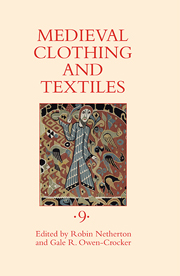Book contents
- Frontmatter
- Contents
- Illustrations
- Tables
- Contributors
- Preface
- 1 Bridal Gifts in Medieval Bari
- 2 The Marriage of the Year (1028)
- 3 Clothing as Currency in Pre-Norman Ireland?
- 4 Cistercian Clothing and Its Production at Beaulieu Abbey, 1269–70
- 5 Clothing and Textile Materials in Medieval Sweden and Norway
- 6 The Iconography of Dagged Clothing and Its Reception by Moralist Writers
- 7 Domestic Painted Cloths in Sixteenth-Century England: Imagery, Placement, and Ownership
- Recent Books of Interest
- Contents of Previous Volumes
3 - Clothing as Currency in Pre-Norman Ireland?
Published online by Cambridge University Press: 05 July 2013
- Frontmatter
- Contents
- Illustrations
- Tables
- Contributors
- Preface
- 1 Bridal Gifts in Medieval Bari
- 2 The Marriage of the Year (1028)
- 3 Clothing as Currency in Pre-Norman Ireland?
- 4 Cistercian Clothing and Its Production at Beaulieu Abbey, 1269–70
- 5 Clothing and Textile Materials in Medieval Sweden and Norway
- 6 The Iconography of Dagged Clothing and Its Reception by Moralist Writers
- 7 Domestic Painted Cloths in Sixteenth-Century England: Imagery, Placement, and Ownership
- Recent Books of Interest
- Contents of Previous Volumes
Summary
Human societies have used many forms of goods as mediums of gift or exchange. Any item to which a value can be assigned, no matter what the nature of that value, might be used as such a medium. It is therefore natural that, throughout history, textile products have been used in this fashion. To the present day, the gifting of garments and accessories remains a general feature of most societies, and in places which use (or once used) barter, garments act as a medium of exchange. A number of societies have at one stage or another taken this process further and utilised textile products in a more formal role in processes of exchange and transaction: more specifically, using particular quantities of textiles as units of currency with established values. Among the better-known examples is China, which early developed sericulture and the production of silk on a large scale, and where both skeins and woven pieces of silk were used as money. In Europe, different Slavic peoples utilised cloth as a means of payment: The Bosnian and Serbo-Croat verb platiti (“to pay”) is derived from the noun platno (“linen”) and quantities of this fabric were used as a form of currency; in the tenth century Franconian Slavs paid various renders in linen cloth. Leathers were used for transactions and renders in medieval France and Italy, while the significance of the regulated Scandinavian wadmal (Old Norse vaðmál) is well known.
- Type
- Chapter
- Information
- Medieval Clothing and Textiles 9 , pp. 55 - 72Publisher: Boydell & BrewerPrint publication year: 2013



